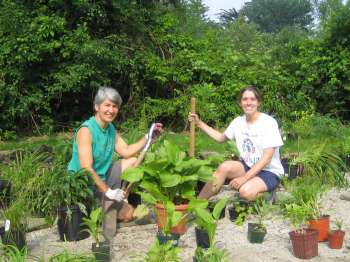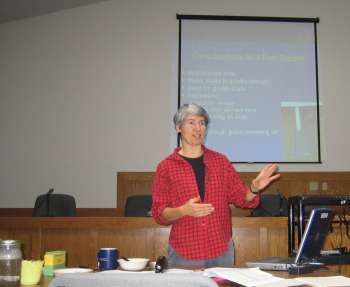- By Dan Veaner
- Around Town
 Print
Print
If you've been watching the square by the Town Hall you've probably been following the progress on the library construction project. If you've been really observant you may have noticed a new garden between the Town Historical Records Building and the Community Center. The garden was installed two weeks ago on the initiative of Sharon Anderson, a Lansing resident and Watershed Steward with the Cayuga Lake Watershed Network. Anderson and and Lansing's environmental planner Darby Kiley planted the garden in one day, ironically a rainy one.

Sharon Anderson (left) and Darby Kiley plant Lansing's new
rain garden on June 19
Rain gardens are a storm water management tool that uses native plants to help facilitate proper drainage. The plants used must be able to be flooded for up to a couple of days, as well as extended dry periods. Some of the plants in the new garden include dogwoods, magnolia, elderberry, cone flower, day lilies, hosta, Syberian iris, swamp milk weeds. The Town had received a $500 Community Beautification Grant from Cornell Cooperative Extension to create a garden. "They weren't exactly sure what they were going to do with it," says Anderson. "When I heard about it I thought, 'let's make it into a rain garden.'"
While the Town intended to put a garden of some kind in that location, Anderson wanted to find the best location for a rain garden. "Initially we were going to put it by the parking area, but then they decided to extend the parking area, so that first location was gone," Anderson explains. "Then I found that there was a gas pipeline, so we had to move past that. And then we found a septic system. It's never ideal to have water flow over a septic system, but that was happening anyway. So the highway crew sloped it to concentrate the area in one point. I hope that will make it move faster, get it off the septic system and get down here."
With a growing focus on storm water management, Anderson's interest in rain gardens has been growing. She planted one at her home, and is promoting their use around the county. Earlier in the month she conducted a workshop on building rain gardens at the Town Hall. She is still learning herself, and is using the Town garden to experiment. "I have too many canna lillies, so I put some in here," she says. "They'll die at the end of this year and we don't plan to replace them. They love wet conditions and I'm putting them here to see what happens. The magnolia will get larger with time, but it's going to take a few years. So they'll hold the space until then."

Anderson teaches about rain gardens at a June 10 workshop
Many of the plants came from Anderson's own garden. "A traditional rain garden has native plants predominantly," she says. "There are a lot of reasons why. Because this is a low budget project I'm using mainly plants that I had in my garden already. Because of my garden I know they will handle these conditions, and also from checking rain garden references. Plantsmen Nursery is now specializing in native plants, and they have donated a bunch."
The garden drains through a hedgerow onto a neighbor's property. "The water used to go straight across onto their lawn," Anderson says. "It will still go somewhat onto their property, but more toward the back. It should be good for neighbor relations as well." Practical and beautiful, the rain garden puts a finishing touch on the town square.
----
v2i25

Sharon Anderson (left) and Darby Kiley plant Lansing's new
rain garden on June 19
Rain gardens are a storm water management tool that uses native plants to help facilitate proper drainage. The plants used must be able to be flooded for up to a couple of days, as well as extended dry periods. Some of the plants in the new garden include dogwoods, magnolia, elderberry, cone flower, day lilies, hosta, Syberian iris, swamp milk weeds. The Town had received a $500 Community Beautification Grant from Cornell Cooperative Extension to create a garden. "They weren't exactly sure what they were going to do with it," says Anderson. "When I heard about it I thought, 'let's make it into a rain garden.'"
While the Town intended to put a garden of some kind in that location, Anderson wanted to find the best location for a rain garden. "Initially we were going to put it by the parking area, but then they decided to extend the parking area, so that first location was gone," Anderson explains. "Then I found that there was a gas pipeline, so we had to move past that. And then we found a septic system. It's never ideal to have water flow over a septic system, but that was happening anyway. So the highway crew sloped it to concentrate the area in one point. I hope that will make it move faster, get it off the septic system and get down here."
With a growing focus on storm water management, Anderson's interest in rain gardens has been growing. She planted one at her home, and is promoting their use around the county. Earlier in the month she conducted a workshop on building rain gardens at the Town Hall. She is still learning herself, and is using the Town garden to experiment. "I have too many canna lillies, so I put some in here," she says. "They'll die at the end of this year and we don't plan to replace them. They love wet conditions and I'm putting them here to see what happens. The magnolia will get larger with time, but it's going to take a few years. So they'll hold the space until then."

Anderson teaches about rain gardens at a June 10 workshop
Many of the plants came from Anderson's own garden. "A traditional rain garden has native plants predominantly," she says. "There are a lot of reasons why. Because this is a low budget project I'm using mainly plants that I had in my garden already. Because of my garden I know they will handle these conditions, and also from checking rain garden references. Plantsmen Nursery is now specializing in native plants, and they have donated a bunch."
The garden drains through a hedgerow onto a neighbor's property. "The water used to go straight across onto their lawn," Anderson says. "It will still go somewhat onto their property, but more toward the back. It should be good for neighbor relations as well." Practical and beautiful, the rain garden puts a finishing touch on the town square.
----
v2i25



